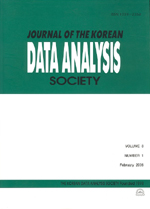한국 도시의 인구규모와 경제규모의 확률분포에 대한 실증연구
The Empirical Analysis of Korea City Population and Economic Size Distribution
- 한국자료분석학회
- Journal of The Korean Data Analysis Society (JKDAS)
- Vol.16 No.4
-
2014.081965 - 1977 (13 pages)
- 46

본 연구에서는 한국 도시규모의 확률분포를 실증적으로 분석하여, 도시규모 불균등 정도의 특징과 변화에 대해 알아보고자 한다. 이를 위하여 2002~2011년 도시인구와 GRDP(지역내총생산) 자료를 이용하여 이동관찰회귀분석을 통해 Pareto 지수를 추정하고 순위-규모 법칙이 적용될 수 있는지를 분석하였다. 실증분석 결과 상위 도시들 사이에서는 인구규모의 불균등 정도가 상대적으로 낮은 반면 하위 도시들 사이의 인구규모 불균등 정도는 심한 것으로 나타났다. 그리고 중하위 도시들 사이에서 인구규모에 비해 경제규모(GRDP 크기)의 불균등 정도가 더 심한 것으로 나타났다. 이는 수도권에 대해서는 개발제한정책을 적용한 반면 지방에는 산업육성정책을 수행한 결과 상대적으로 중규모 도시의 경제가 급속히 성장하였기 때문이라고 생각된다. 한편 대도시와 중규모 도시는 인구규모와 경제규모가 함께 지속적으로 성장해 왔지만 소규모 도시는 경제규모의 성장이 지체된 것으로 나타났다. 따라서 도시들 사이의 경제규모 불균등 정도를 완화하는 정책이 필요하며, 이를 위해서는 특히 소규모 도시에 입지 경쟁력이 있는 산업을 유치하여 경제성장을 촉진시키는 정책이 필요하다고 본다. 경제규모의 불균등이 완화되면 인구규모의 불균등도 점차 완화되어 국토균형발전에 도움이 되고 국민들의 삶의 질이 개선될 수 있을 것이다.
This article presents the feature of uneven development between cities and its change trend, which are concluded by analyzing the distribution of city size in South Korea. Through rolling window regression, Pareto exponents are measured based on the data of urban population and gross regional domestic product (GRDP) from 2002 to 2011 to verify the rank-size rule. The analysis results are as follows: The disparity between big and medium-sized cities is relatively small, while the gap between middle-sized and small cities is comparatively large. All these may be attributed to the fact that the policy of restricting development is implemented among capital economic circle with the policy of supporting industry adopted in local areas. Medium-sized cities maintain a faster economic growth. By contrast, small cities show stagnant growth. Consequently, the subsequent policy priorities shall be given to strengthening the competitiveness of small cities as well as accelerating rational distribution of industries. Diminished disparity at economic level will facilitate the bridging of population gap between cities, which will make for the balanced development between regions and fundamentally improve the living standards of people.
1. 서론
2. 선행연구
3. 분석자료 및 분석방법
4. Pareto 지수 추정결과 및 분석
5. 결론
References
(0)
(0)